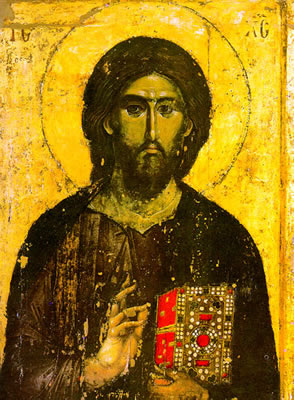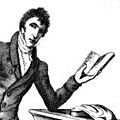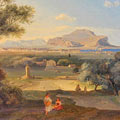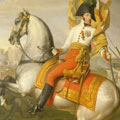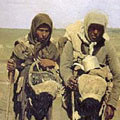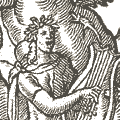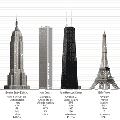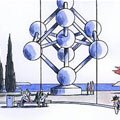Acht jaar geleden kwam ik uit Griekenland terug met een vuistdikke catalogus van de tentoonstelling Treasures from Mount Athos die ik tweemaal bezocht had in het Byzantijnse Museum in Thessaloniki. Deze unieke tentoonstelling werd gehouden in het kader van de manifestatie Thessaloniki cultural capital of Europe 1997. Gisterenavond was ik weer eens aan het bladeren met aansluitend een surfsessie. De integrale catalogus staat namelijk (nog altijd) online. Met uniek beeldmateriaal.
Christus Pantokrator uit het klooster Chelandari geschilderd omstreeks 1260-1270
This icon of Christ Pantokrator and the icon of the Virgin Hodegetria (no. 2.9) are outstanding works of art painted about 1260-70 by an exceptionally gifted artist. They have the same dimensions and seem originally to have been despotic icons on the old templon in the katholikon of Chelandari Monastery.
Christ is depicted from the waist up in a frontal pose. He holds a closed Gospel ornamented with pearls and gemstones in his left hand and his right is raised in blessing. He wears an aubergine tunic and a deep blue himation.
The stern monumental figure of Christ, with the long narrow face, the robust neck with its schematic musculature, and the muscular palm of the right hand with the stylised joints on the large fingers, refers to wall paintings and icons of the second half of the thirteenth century (Soteriou 1956, fig. 196. Djuric 1963, pl. XLII. Tsigaridas 1996 (1), figs. 309, 312).
Despite the damage to the paint film, in the rendering of the face the olive-green underpainting is limited and functions as shading, while the ochre of the more predominant areas of flesh is illuminated with linear highlights on the brow and around the eyes. It is interesting to note that the distribution and function of the highlights on the brow and around the eyes are also seen in icons in Vatopedi from the second half of the thirteenth century (Tsigaridas 1996 (1), figs. 309, 312).
The monumental aspect of the figure, the calm, deeply pensive face with its benevolent expression, the plastic rendering of the face, and the breadth of the body make this icon one of the masterpieces of Byzantine painting and link it with the frescoes at Sopocani (ca. 1265) in Serbia (Djuric 1963, pl. XLII) and the expressive quality of the icon of Christ Pantokrator (1262-3) at Ochrid (Weitzmann et al. 1982, p. 126). The anonymous painter, who must be regarded as one of the most outstanding artists of the Byzantine period, gives the impression in this icon that he is reviving the expressive quality and the merits of the visual art of the early Christian period, as represented, for instance by the encaustic icon of Christ Pantokrator (6th c., 1st half) in the Monastery of St Catherine on Mount Sinai (Galavaris 1990, pp. 92-3, figs. 1-2).
Treasures from Mount Athos


